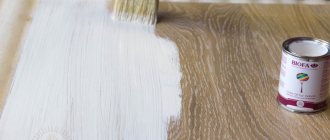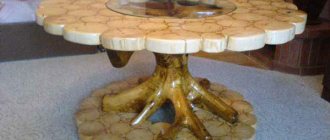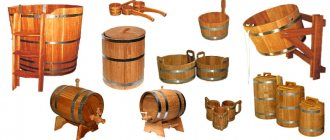Many professional carpenters make their own oils to save money. However, it is extremely important to follow the recipe, monitor the amount of ingredients and accurately carry out each stage of creating the impregnation. We'll tell you how to make oil for impregnating wood with your own hands and how practical it is in general.
Is it possible to make wood treatment oil yourself?
Yes, you can. For this, as a rule, natural ingredients are used: linseed oil and wax.
Flaxseed oil is a classic wood impregnation agent.
They are mixed in a ratio of 4 to 1, adding in the required quantities:
- turpentine - allows the oil composition to better penetrate the wood structure;
- rosin - makes the surface of the wood harder.
In addition, various pigments can be added to the oil.
Impregnation based on linseed oil
Pure flaxseed oil is the simplest and most affordable ingredient. It can be safely used to create kitchen utensils, such as cutting boards or hot pads. You should use the purest, fat-free, cold-pressed oil possible - a product with impurities can lead to the formation of mold.
Pure linseed oil can dry for almost 2 months
Craftsmen often use bleached oil - this is easier to mix with dyes. But you should understand that it will be quite expensive - about 1,500 rubles per liter. Whereas unbleached oil can be found at a price of about 700 rubles per liter.
Linseed oil based impregnations usually dry within 6-8 weeks. To speed up this process, tung oil can be added to linseed oil at the first or second stage of applying impregnation. In this case, the oil coating dries for about a week.
However, it must be used with extreme caution - preferably wearing rubber gloves, since tung oil is a very strong irritant. The most popular mixing ratios of linseed and tung oil are 1:3 or 1:5. Professional masters recommend experimenting and looking at the results in fact.
You can also use walnut oil instead of tung oil. But it also has its limitations. Professional carpenters recommend using it for crafts that are not often used in everyday life - the rancid smell of the oil takes quite a long time to evaporate.
Pigments are used to color the oil - preferably on a natural basis. Before mixing them with oil, the pigments must be dissolved in turpentine. The main thing with adding dye is not to overdo it. The optimal ratio of pigment and oil is 1:10.
As mentioned above, resinous rosin increases the hardness of wood after application of impregnation. Before adding rosin, it must be dissolved - to do this, the resin is heated to 130-150 °C. The difficulty in using rosin lies in the dosages. The more you add, the more viscous and sticky the oil becomes. Therefore, the required amount of rosin has to be measured after the fact, adding a little to the impregnation and monitoring its viscosity.
Another disadvantage of rosin is that it is a rather strong allergen.
Wax based impregnation
It is better to buy beeswax from reliable suppliers - this minimizes the risk that you will receive a dirty product
Most often, natural beeswax or carnauba wax is used in woodworking. Both of them dissolve well in turpentine or white spirit. Beeswax is soft and easier to work with than hard carnauba wax. However, the latter enhances the shine of the wood and makes it smoother.
In addition, the following can be used as wax additives to create oil:
- candelilla wax;
- ozokerite (earth wax);
- stearin;
- shellac.
We'll tell you how to make wood oil using a couple of simple examples.
Technology of impregnating wood with linseed oil
From the point of view of the processing process, the technology of impregnation with linseed oil does not differ from impregnation with other oils or compounds. Consists of the following steps:
- Surface preparation - cleaning of dirt, dust, old coating. Also, the wood must be dry. To process unused wood, you need to lightly sand its surface.
- It is advisable to warm the oil a little before applying. When warm, it penetrates more easily into the pores of the wood. This will result in higher processing efficiency.
- To make the oil dry faster, it is applied together with wax. Which is added to the oil and heated until the wax melts
You can treat wood with oil in the following ways:
- Apply the oil using a bone or foam sponge. The oil should be applied along the fibers using rubbing movements. Application is repeated 5-6 times. After the last application, a few hours later, remove excess oil with a dry cloth.
- By soaking the wood (if dimensions allow) in a container with heated linseed oil (until white smoke appears from the oil), so that the oil completely covers the wood. Close the lid and leave for two to three hours. Remove and dry
- Drying wood after treatment with linseed oil
- It takes 14-20 days for the wood to dry completely after treating it with oil. After the wood has dried, the surface is sanded using wax, rosin or turpentine.
Subscribe to our Yandex.Zen channel
You might be interested
- 12/05/2018 2019 Year of the Yellow Earthen Pig - what to change in the interior.
- 09.11.2019 What kind of wood to make a staircase from
- 12/29/2017 Luxurious dining room for an aristocrat
- 04/26/2019 All about coniferous resin
- 10/02/2016 Topographic survey from GlavGeoProject
Recipe with added wax
The simplest option is wax impregnation without the use of a solvent, which will give the wood a pleasant silky shine. You will need:
- 100 grams of flaxseed oil;
- 4 grams of beeswax;
- 2 grams of carnauba wax.
Heat the oil to 90 degrees and add wax. Stir the mixture until the wax is completely dissolved. The resulting impregnation should not be too thick, but not too liquid. Wax oil is thixotropic - in a calm state it becomes viscous, but if you shake the container, the impregnation will become more liquid.
Selection of oil-wax
The key criterion is the composition of the product, what components are included in it. The final result and tone of the wood directly depend on this.
The product consists of:
- oil (linseed, olive or jojoba);
- beeswax;
- colors for color saturation;
- a solvent that makes the product not so thick (the lower its mass fraction, the faster the hardening occurs).
If you buy a ready-made product, make sure that the composition does not contain aggressive solvents or benzene. It is also necessary to take into account the type of wood, since both the absorption rate and the consumption of the product directly depend on this. Compositions for hardwood, softwood and exotic woods are available.
Oil-wax often contains additives that make the surface glossy and shiny. It looks impressive, and this product is suitable for interior work. But be careful, as the coating becomes slippery when treated with the composition.
How practical is this?
With TORVENS oil you will be spared unnecessary hassle when processing wood
As you can see from the examples, you can make your own wood processing oil. How much of a cost savings issue is there? Let's count taking into account 1 liter of composition.
- Bleached butter in various stores costs from 350 rubles. (for wholesale purchase) up to 1000 rub. per liter
- 20 gr. carnauba wax will cost about 120 rubles.
- 40 gr. beeswax will cost about 30 rubles.
Taking into account the most affordable ingredients when purchasing goods in bulk, homemade impregnation will cost approximately 450–500 rubles (minimum). A ready-made purchased option can cost from 1000 rubles and more. But there are two problems here:
- Making your own oil is a rather complicated process. The ingredients need to be found and purchased, and then carefully measured and mixed. Some ingredients may remain unused - this is also an expense item.
- Even a small change in the concentration of components can have a serious impact on the final result. For example, a resin concentration that is ideal for floors will not be the best solution for walls. Strict adherence to the temperature regime is also of great importance - when making oil at home, it is very difficult to control the temperature.
If you need very durable and high-quality oiled surfaces, it is better to buy wood treatment oil. Ready-made mixtures are universal, you don’t need to think about the dosage - just open the jar and get to work. The result is savings in effort and nerves.
An example of an affordable and easy-to-use impregnation is TORVENS wood treatment oil, which has many advantages:
- protects against blue stains, mold and fungi;
- perfectly reveals the texture of wood;
- protects against abrasion under mechanical loads;
- has moisture- and dirt-repellent properties;
- creates a breathable, elastic surface that does not peel or crack;
- easy to apply with a brush in two layers;
- updated without additional surface cleaning.
TORVENS oil has a wide range of applications. It can be safely used for wooden floors, stairs, interior doors, walls and ceilings. It is suitable for processing coniferous and deciduous wood. In this case, the oil can be used both for primary treatment and surface renewal.
The oil contains modified linseed oil, rosin ester, wax, UV filter, antiseptic additives, driers and pigment pastes. The oil ceases to be sticky within 8 hours after application. And subsequent layers are applied after 16–24 hours, depending on drying conditions.
Benefits of wax oil
Previously, yacht varnish was mostly used for this purpose, and it perfectly protected the wood from the harmful effects of moisture. The composition makes the color of the wood beautiful and rich, and the structure of the fibers – clearly expressed.
Oil-wax for wood coating
But varnish has its drawbacks. It wears out and cracks, and therefore needs to be renewed regularly (every 5-6 years, depending on the intensity of use). Removing the old layer is a complex process, and applying a new coating is associated with considerable difficulties. The varnish is toxic, and therefore precautions must be taken.
Compared to it, oil-wax has a number of advantages:
- Easy to apply. Even hand-prepared compounds can be easily rubbed into a wooden surface.
- Non-toxic. These products contain caustic components, and therefore you need to be careful when working with them. But most often, oil-wax is made from natural ingredients - non-toxic and safe for human health.
- Vapor permeability. If varnish tightly clogs pores and all kinds of holes, then oil-wax preserves them. Wood “breathes”, which leads to natural ventilation and prevents rotting processes.
- Practicality. When applied correctly, these compounds provide excellent protection against sudden changes in temperature, humidity and mold.
- Deep penetration. The varnish remains on the surface of wooden products, while the oil-wax penetrates deep into the structure of the fibers and provides more reliable protection.
If previously, when replacing floorboards, you had to remove the entire layer of varnish and reapply, now this can be avoided. You simply lay down a new board and coat it with the same compound that was used on the floor. This ensures a uniform structure of the entire coating.
When applying wax, the wood fibers remain free and not constrained. If the floorboards are laid on a heated floor system, then when the temperature changes, cracks will not appear on the surface of the wood, since it will be able to expand and contract in volume without deforming.
Ideal painting of wooden products with oil.
Take a look at these three oil finishing techniques and take advantage of their unique benefits. Now, don't get me wrong, but the classic oil finish is not perfect. Its main disadvantage is the long duration of the finishing process itself. Oil finish does not form a protective film, so it is not used on heavily used surfaces such as a dining table, etc. Application. Oil finishing takes longer than other types of finishing. Oils, by nature, dry slowly, so typically apply only one coat per day. (In cool, humid conditions, you may have to wait two days.) I recommend applying four to five coats of oil, which will create a beautiful finish and create the greatest protection for wood. In a nutshell, how to properly apply an oil finish. For the first layer (priming), pour oil onto the surface of the product and let it soak into the wood. After 20-30 minutes, remove excess oil. For the next layer, I rub a thin layer of oil into the workpiece and then wipe off the excess. When the product is completely dry (about one to two days), the project is ready.
Properties
Oil extracted from flax seeds is used as a culinary product and a multifunctional technical product. A large number of useful qualities are due to its structure and chemical composition.
The basis of the unrefined plant extract is triglycerides, including from 60% to 90% polyunsaturated (linoleic and linolenic) acids. The biological significance of such acids is multifaceted, which is why flax seed oil is widely used as a food additive.
For production purposes, in particular for coating wood with linseed oil, technical grades with a less thorough degree of purification are used. When dried, the acid residues polymerize, forming a durable film similar to a drying oil coating.
Quick and easy combination finishing
Traditional oil finishing looks beautiful - but the finishing process is time-consuming. There is a way to achieve a clean oil finish with a longer lasting finish and less wasted time. The process begins by applying a thin layer of oil to the piece—just enough to give it a warm color. Then wipe off the excess until the surface is dry. After letting the oil sit for 30 minutes, you can seal and protect it with shellac and varnish. Follow the instructions in the photo below.
Shellac Filler. Apply two or three layers of shellac over the oil layer. Let the shellac dry with 10-15 minutes between coats. Then use fine sandpaper to smooth the surface of the product.
Top Layer of Varnish. To add shine and increase the durability of the finish, apply a coat of varnish to the product every two hours after the previous coat has dried.
Polishing. Use a wool rag and polishing paste to give the top coat a satin finish.











